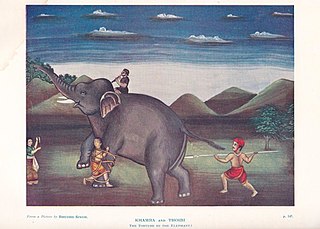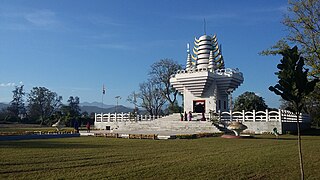
Manipur is a state in northeast India, with the city of Imphal as its capital. It is bounded by the Indian states of Nagaland to the north, Mizoram to the south and Assam to the west. It also borders two regions of Myanmar, Sagaing Region to the east and Chin State to the south. The state covers an area of 22,327 km2 (8,621 sq mi). The official and most widely spoken language is the Meitei language. Native to the Meitei people, it is also used as a lingua franca by smaller communities, who speak a variety of other Tibeto-Burman languages. Manipur has been at the crossroads of Asian economic and cultural exchange for more than 2,500 years. This exchange connects the Indian subcontinent and Central Asia to Southeast Asia, East Asia, Siberia, regions in the Arctic, Micronesia and Polynesia enabling migration of people, cultures and religions.

The Meitei people, Meetei people, or Manipuri people is an ethnic group native to Manipur. They form the largest and dominant ethnic group of Manipur in Northeast India. They speak the Meitei language, one of the 22 official languages of the Indian Republic and the sole official language of Government of Manipur. The Meiteis primarily settled in the valley areas in modern-day Manipur, though a sizeable population has settled in the other Indian states of Assam, Tripura, Nagaland, Meghalaya, and Mizoram. There is also a notable presence of Meitei people in the neighbouring countries of Myanmar and Bangladesh. The Meitei ethnic group represents about 53% of Manipur's population.

Sanamahism, Meiteism, or Lainingthouism is an ethnic religion of the Meitei people of Kangleipak in Northeast India. It is a polytheistic religion and is named after God Lainingthou Sanamahi, one of the most important deities of the Meitei faith. Sanamahi is the eldest son of the supreme god Yaibirel Sidaba and the supreme goddess Leimarel Sidabi. Traditionally every Meitei household, irrespective of the religion, worships Sanamahi and Leimarel Sidabi. The importance of Sanamahi in the religion is also emphasized in the name itself which means Liquid Gold. Sanamahism does not have a religious head but has a body, Maru Loishang that oversees the main religious activities and govern all affairs pertaining to the religion including conducts of priest and priestess. The Maru Loishang also acts a court for religious disputes. There are three main departments under the Pandit Loishang, namely, the Amaiba Loishang, the Pena Asheiba Loishang and the Amaibi Loishang. These departments have existed since the reign of King Meidingu Hongnemyoi Khunjao Naothingkhong of Manipur in 662 AD.

Lai Haraoba is a traditional Meitei religious festival of ritual dance and musical theatre, celebrated annually in honour of Umang Lais, the forest deities of Sanamahism.

Pakhangba is a primordial deity, often represented in the form of a Meitei dragon, in Meitei mythology and religion. He is depicted in the heraldry of Manipur kingdom, which originated in paphal, mythical illustrations of the deity in the traditional beliefs of Sanamahism in Manipur. Among the Meiteis, it is believed that the ancestor of one of the clans manifested himself as the Pakhangba.
Laininthou Sanamahee is the Supreme Guardian God of mankind and the supreme deity of the household in Meetei religion and mythology. He originated from the ancient kingdom of Kangleipak (Manipur). He is regarded as the most popular and significant divinity of Sanamahism. He is the brother of Pakhangba and Nongshaba. He is the eldest son of Creator God Saalailel Sitapa and Leimalel Sitapee, the protector of the Universe in Meetei mythology and philosophy and Mother Earth goddess Leimarel Sidabi.

Leimarel Sidabi or Leimalel Sitapi is a goddess in Meitei mythology and the religion of Ancient Kangleipak. She is the highest female divinity in the Meitei pantheon. She is the goddess of earth, of nature and the household. She is revered as the mother of every living being in the universe.

Meitei folklore is the folklore and mythology of the Meitei people of Manipur, India.
Sanamahi Ahong Khong Chingba or Sanamahi Cheng Hongba or Kang Chingba is the religious festival of Meitei people, associated mainly with the public procession with the grand chariot, housing the ancient Meitei deity Lainingthou Sanamahi. The Imphal city serves as the main location of the festival. It attracts thousands of pilgrims who join the procession. The festival was celebrated 350 years ago, and after a long pause, it was first recelebrated in the year 2018.

Hinduism is one of the major religions practiced in the state of Manipur, India. Hinduism is concentrated in the Imphal Valley and other plain districts of Manipur located in the regions neighbouring Assam state. Hinduism is practiced mostly among the Meitei people, who are the predominant ethnic group of Manipur. Whilst the proportion of Manipur's population that practices Hinduism is roughly 41%, in the Manipur valley region Hindus constitute as much as 67-74% of the population. Between the 1961 and 2011 censuses of India, the share of Hindus in the state declined from 62% to 41%, while the share of Christians rose from 19% to 41%.

Nongpok Ningthou, also known as Sovereign of the East or King of the East, is a deity in Meitei mythology and religion of Ancient Kangleipak. He is the ruling guardian deity of the eastern direction. Legend says Nongpok Ningthou and Panthoibi got united in the Nongmaiching mountains. Later, they were worshipped as the civilization giving deities in Meitei religion.

Noinu Thumleima or Thumkhong Lairembi is the goddess of salt and salt wells in Meitei mythology and religion of ancient Manipur. She is a sister of the goddesses, Phouoibi (Phouleima), Ngaleima and Ereima (Ireima). People pray to her so there will be enough salt. Salt is an important part of the human diet.

Panam Ningthou is a God in Meitei mythology and religion. He is the protector of crops, especially paddy from hailstorm and thunder. According to legends, He ignited fire for the first time by rubbing flints. He is one of the Umang Lai deities.

A Helloi or Heloi is a female nature spirit in Meitei mythology, folklore and religion. Hellois are often depicted in the forms of beautiful young women. They are often associated with seduction of men. They are the most powerful among the female spirits. They can cause diseases. The hellois are often known for their charming beauty, ecological balance and seduction of males. Hellois are sometimes seen as evil spirits in the forms of beautiful maidens.

Thangching or Thangjing is a primordial deity in Meitei mythology and religion of Ancient Kangleipak. He is the ruling deity of the Moirang dynasty of Ancient Moirang. He rules supreme on the banks of the landlocked sea, Loktak lake. He is one of the four cardinal Umang Lais. The guardianship of the south western direction is alluded to Thangjing and the other directions to Koubru, Marjing and Wangbren.

The culture of Meitei civilization evolved over thousands of years, beginning in Ancient Kangleipak, continuing most notably into Medieval Kangleipak, while influencing the neighboring states and kingdoms, till present times.
Ucheks have significant roles in different elements of Meitei culture, including but not limited to Meitei cuisine, Meitei dances, Meitei festivals, Meitei folklore, Meitei folktales, Meitei literature, Meitei mythology, etc.

The cultural heritages of Meitei civilization has classicism in diverse traditions of cinemas, dances, language, literature, music, theatre, etc.













